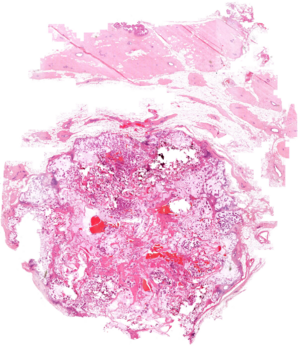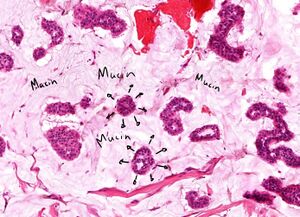42. Mucinous carcinoma: Difference between revisions
(Created page with "''This slide is no longer part of the curriculum as of spring 2020, so you shouldn’t have to learn it.'' '''Staining''': HE '''Organ''': Breast '''Description''': The top of the slide shows normal breast tissue. The tumor is obvious. The tumor cells form clusters that are “floating in a sea of mucin”. These tumor cells have lost their orientation and therefore secrete mucin outwards instead of inwards (into an acinus) '''Diagnosis''': Mucinous carcinoma '''R...") |
(No difference)
|
Revision as of 20:58, 15 November 2022
This slide is no longer part of the curriculum as of spring 2020, so you shouldn’t have to learn it.
Staining: HE
Organ: Breast
Description:
The top of the slide shows normal breast tissue. The tumor is obvious.
The tumor cells form clusters that are “floating in a sea of mucin”. These tumor cells have lost their orientation and therefore secrete mucin outwards instead of inwards (into an acinus)
Diagnosis: Mucinous carcinoma
Risk factors:
- Usually older women
- Probably same as for other breast cancers
Theory:
Mucinous carcinoma is a rare type of breast carcinoma, accounting for less than 3% of cases. It has a better prognosis than invasive ductal carcinoma.


